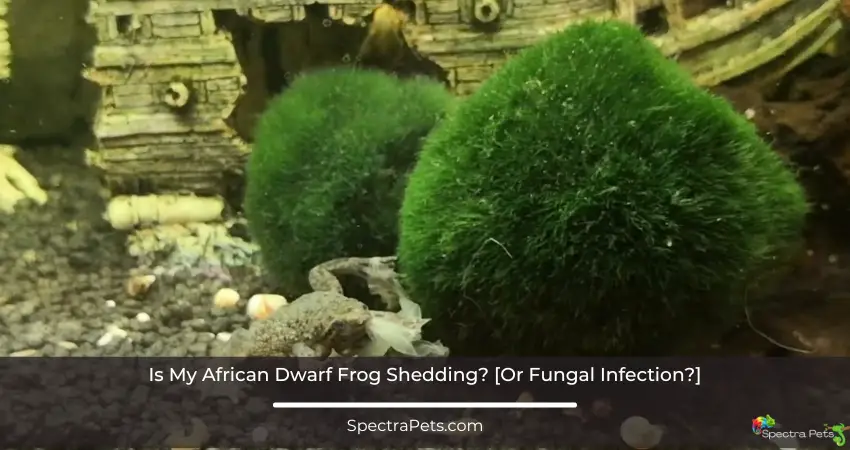All of a sudden, the skin of your pet African Dwarf Frog appears to be falling off and hanging loose. Is it actually a problem? Or is it completely normal?
Well, the answer could be both yes and no to both of the questions. This could be an indication that your pet frog is shedding its skin. It could also mean that your frog has been infected with a fungal infection.
Another possibility would be that the water in the tank is not exactly suitable for the frog, or a sudden change of environment and water conditions might have an effect on its physicality.
But which one is it exactly? And how do you identify the actual cause?
In this article, we’ll have a deeper look into all the possible reasons behind the African Dwarf Frog looking fuzzy, and what to do while it’s at it.

Is it normal for African Dwarf Frogs to shed?
Dwarf frogs are completely normal in their behavior when it comes to shedding their skin. The growth is an indication of their physical development. A frog experiencing substantial physical changes at this stage is prone to this condition.
Even as an adult, these frogs continue to shed skin on a monthly basis. They may also feed on their own shed skin.
How do I know if my frog is shedding?
If your pet frog is shedding skin due to natural growth, the skin will turn white or pretty pale in color after shedding. When the shedding is natural, it will come off in one piece instead of smaller patches, just like that of a snake. If this is the case, then you don’t need to worry much, as it is showcasing completely normal behavior.
Fungal Infections: How do I know if my African Dwarf Frog has chytrid?
African Dwarf Frogs have a pretty high mortality rate, and fungal infections have taken away the lives of quite a lot of African Dwarf Frogs. One such infection is called chytridiomycosis. It is caused by a fungus called the chytrid fungus. This species of frog is extremely vulnerable to this fungal infection.

Once your frog is infected with this, hairy white patches will start appearing all over its body and the skin will start peeling from these spots. In this instance, the shedding of the skin is an attempt by the frog to get rid of the fungal infection. It will also shed its skin way more often than usual.
The frog will also start behaving weirdly. It will fanatically try to get out of the aquarium, won’t eat or move much, and will be hiding in the hiding spots of the aquarium. You must handle this situation carefully, as this infection if left alone, can be deadly.
How to know if an African Dwarf Frog is shedding because of bad water?
As fragile as they come, this species of frog is highly susceptible to unfavorable tank conditions as well. Sharp edges from the decor of the aquarium may cut into the skin of the frog, forcing your African clawed frog to shed skin in an attempt to heal any injuries.
The temperature and pH level of the water in the tank are also very crucial. Sudden changes in these parameters cause unease to your frog and it may start shedding the skin as a sign of discomfort. The optimal water temperature for these frogs lies between 75°F and 78°F, and the pH level needs to be between 6.5 and 7.5.
Dirty water is another possibility. These frogs are not known as the cleanest. Unsanitary conditions in the tank will also cause them to shed skin more often than usual, so try to keep the aquarium as clean as possible by regularly filtering and changing the water.
Read Also: African Dwarf Frog Tank Setup Guide
How to treat Chytridiomycosis of African Dwarf Frogs
First of all, you need to quarantine the individual infected frogs as soon as you detect fungal infections. If you don’t, the infection will reach other animals in the aquarium in no time. The chytrid fungus needs about 8 weeks to mature, so you must quarantine the individual frog for at least that period of time.
In the early stages, this fungal infection can be treated with antifungal medicines such as itraconazole or benzalkonium chloride. Bathing the frog with a 0.2g/liter benzalkonium chloride-water solution every three weeks will significantly reduce the mortality rate by as much as 70%.
In any case, you need to consult your vet, as they are professionals that know the best way to handle this, along with prescribing the correct medicine at every stage.
Do I have to remove the shed skin from the tank?
Well, unless the skin has been shed due to bacterial or fungal infection, you don’t need to remove it from the aquarium. The frog will eventually have a bite of its own skin, and why not? It packs a lot of nutrients!
If the skin hasn’t been consumed after a couple of days, remove it. It will rot and start gathering bacteria if it stays in the aquarium for too long.
Final Thoughts
Shedding skin is a natural behavior of your beloved pet frogs, so you don’t immediately need to be alarmed. Instead, observe and investigate the actual reason, and take action accordingly. Quarantine and seek veterinary help when necessary, and clean the aquarium as often as possible. Keeping the tank as clean as possible will only be beneficial to them, and increase their longevity substantially.
Similar Articles:
